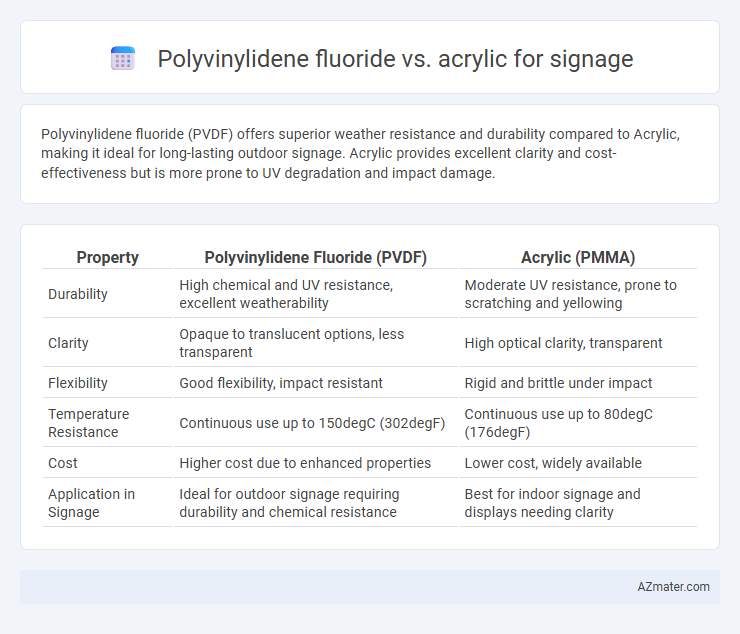Polyvinylidene fluoride (PVDF) offers superior weather resistance and durability compared to Acrylic, making it ideal for long-lasting outdoor signage. Acrylic provides excellent clarity and cost-effectiveness but is more prone to UV degradation and impact damage.
Table of Comparison
| Property | Polyvinylidene Fluoride (PVDF) | Acrylic (PMMA) |
|---|---|---|
| Durability | High chemical and UV resistance, excellent weatherability | Moderate UV resistance, prone to scratching and yellowing |
| Clarity | Opaque to translucent options, less transparent | High optical clarity, transparent |
| Flexibility | Good flexibility, impact resistant | Rigid and brittle under impact |
| Temperature Resistance | Continuous use up to 150degC (302degF) | Continuous use up to 80degC (176degF) |
| Cost | Higher cost due to enhanced properties | Lower cost, widely available |
| Application in Signage | Ideal for outdoor signage requiring durability and chemical resistance | Best for indoor signage and displays needing clarity |
Introduction to Signage Materials
Polyvinylidene fluoride (PVDF) and acrylic are two prominent materials used in signage due to their durability and aesthetic properties. PVDF offers exceptional resistance to UV radiation, chemicals, and weathering, making it ideal for outdoor signs requiring long-term color retention and structural integrity. Acrylic provides high optical clarity and versatility, commonly chosen for illuminated signs and indoor applications where sharp visuals and smooth finishes are essential.
Overview of Polyvinylidene Fluoride (PVDF)
Polyvinylidene Fluoride (PVDF) is a high-performance thermoplastic known for its outstanding chemical resistance, UV stability, and durability, making it ideal for long-lasting exterior signage. PVDF coatings provide superior color retention and weather resistance compared to acrylic, ensuring signage maintains its visual appeal in harsh environmental conditions. This material is favored in industrial and architectural applications where longevity and minimal maintenance are critical.
Overview of Acrylic
Acrylic is a versatile thermoplastic commonly used in signage due to its excellent clarity, weather resistance, and ease of fabrication. It offers superior UV resistance and color retention compared to many other plastics, making it ideal for outdoor applications. Acrylic's lightweight and impact-resistant properties also contribute to its popularity in both indoor and outdoor sign displays.
Comparative Durability: PVDF vs Acrylic
Polyvinylidene fluoride (PVDF) exhibits superior durability compared to acrylic in outdoor signage applications due to its exceptional resistance to UV radiation, chemical corrosion, and weathering effects. PVDF coatings maintain color stability and structural integrity for over 20 years, whereas acrylic signs often fade and become brittle within 5 to 7 years under similar environmental exposure. This makes PVDF the preferred choice for long-term signage requiring minimal maintenance and sustained aesthetic appeal.
Weather Resistance: Which Material Performs Better?
Polyvinylidene fluoride (PVDF) outperforms acrylic in weather resistance due to its superior UV stability and chemical resistance, making it highly suitable for long-term outdoor signage applications. PVDF coatings maintain color vibrancy and structural integrity under harsh sunlight, rain, and temperature fluctuations, whereas acrylic tends to yellow, crack, and degrade over time when exposed to similar conditions. This makes PVDF the preferred material for weather-resistant signage in environments with intense sun exposure and extreme weather variations.
Color Retention and Fading in Signage
Polyvinylidene fluoride (PVDF) coatings exhibit superior color retention and resistance to fading compared to acrylic, making them ideal for long-term signage exposed to harsh UV radiation. PVDF maintains vibrant colors for decades due to its strong UV stability and chemical resistance, while acrylic signage often suffers from quicker degradation and color loss in outdoor environments. Choosing PVDF ensures durability and consistent visual appeal, significantly reducing maintenance and replacement costs over time.
Installation and Maintenance Differences
Polyvinylidene fluoride (PVDF) offers superior durability and resistance to harsh weather conditions compared to acrylic, making it ideal for long-term outdoor signage installations. PVDF requires less frequent maintenance due to its UV and chemical resistance, while acrylic signage may need regular cleaning and occasional replacement from fading and cracking. Installation of PVDF panels often demands specialized tools and professional expertise, whereas acrylic is lighter and easier to cut, facilitating quicker, more straightforward installation.
Cost Analysis: PVDF vs Acrylic Signage
PVDF signage typically presents a higher initial cost compared to acrylic due to its superior durability and resistance to UV degradation, making it a long-term investment for outdoor applications. Acrylic offers a more budget-friendly option with lower upfront expenses but may incur higher maintenance and replacement costs over time due to susceptibility to weathering and fading. Evaluating total cost of ownership reveals that PVDF delivers enhanced longevity and reduced lifecycle costs despite its premium price.
Environmental Impact and Sustainability
Polyvinylidene fluoride (PVDF) offers superior durability and chemical resistance, leading to longer-lasting signage with reduced need for frequent replacements, thereby minimizing waste and environmental impact. Acrylic, while lightweight and versatile, tends to degrade faster under UV exposure, resulting in shorter lifecycle and increased material consumption over time. PVDF's recyclability and lower maintenance requirements contribute significantly to sustainable signage solutions, making it a more environmentally responsible choice compared to acrylic.
Choosing the Right Material for Your Signage Needs
Polyvinylidene fluoride (PVDF) offers superior weather resistance and chemical stability, making it ideal for long-term outdoor signage exposed to harsh environmental conditions. Acrylic provides excellent clarity and impact resistance, well-suited for indoor applications or illuminated signs requiring vibrant colors. Selecting between PVDF and Acrylic hinges on durability requirements, environmental exposure, and visual impact preferences to ensure optimal performance and longevity for your signage.

Infographic: Polyvinylidene fluoride vs Acrylic for Signage
 azmater.com
azmater.com